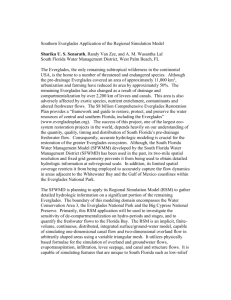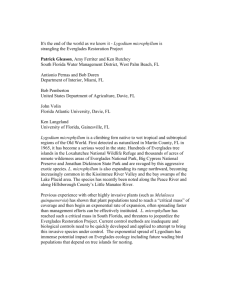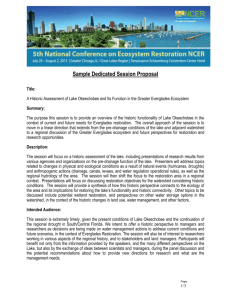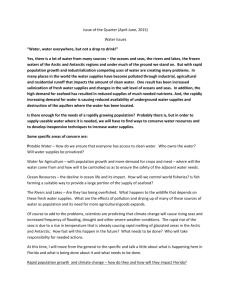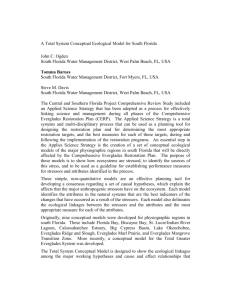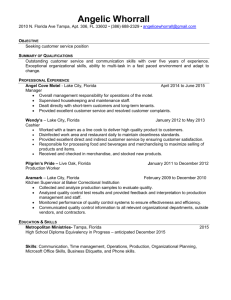South Florida Watershed
advertisement
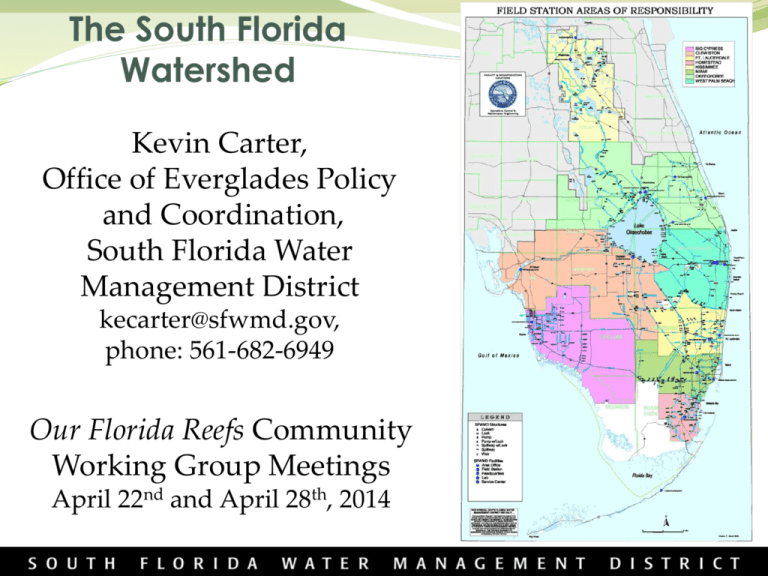
The South Florida Watershed Kevin Carter, Office of Everglades Policy and Coordination, South Florida Water Management District kecarter@sfwmd.gov, phone: 561-682-6949 Our Florida Reefs Community Working Group Meetings April 22nd and April 28th, 2014 1 Presentation Overview Central & South Florida Flood Control System (CS+F): History, Scale, and Complexity Restoration at the Watershed Scale: CERP, Comprehensive Everglades Restoration Plan CEPP, Central Everglades Planning Project RS, Restoration Strategies NEEPP, Northern Everglades + Estuaries Protection Program (hint: you will learn these acronyms, test at the end ) 2 What does the term Watershed mean to you? “In the continental US, there are 2,110 watersheds; including Hawaii Alaska, and Puerto Rico, there are 2,267 watersheds” http://water.epa.gov/type/watersheds/ whatis.cfm Photo from http://www.nsrwa.org/Page.121.html The South Florida Watershed Historic Current 4 Historical Events Leading to Construction of C&SF Project Hurricanes in 1926 and 1928 resulted in failure of the levee around Lake Okeechobee Lower East Coast drought (1931 – 1945) and saltwater intrusion threat Hurricane in 1947 resulted in wide-spread flooding throughout South Florida State of Florida requested Federal assistance in 1947 Congress authorized the C&SF Project in 1948 Areas Flooded in the 1947 Storm Today’s SFWMD • Lands stretch 240 miles from Orlando to the Keys • 18,000 sq. miles, encompassing one of the most diverse ecosystems in the world • ~2,000 miles of canals • ~2,800 miles of levees • More than 650 water control structures and 700 project culverts • Nearly 70 pump stations • 7.7 million residents • More than 3 million acres of agriculture • Protected/Managed natural areas www.sfwmd.gov SFWMD Core Mission Five Water Management Districts were created by 1972 Water Resources Act: Flood Control Operate & maintain largest water management system in the world Water Supply Ensure sustainable water resources for South Florida’s environment and economy Natural Systems Protect and restore the Northern and Southern Everglades Water Quality Improve water quality in the Everglades 7 Future South Florida Watershed: Increasing Flows to the South Pre-drainage Flows Managed Flows (circa 2010) 8 Future South Florida Watershed: Increasing Flows to South (cont.) 9 CERP: A Very Brief Background 1999 – Florida Legislature gives SFWMD authority to act as local sponsor for all portions of C&SF 1999: The C+SF Restudy submitted to Congress; comprehensive plan with more than 60 components 2000: Florida Legislature passes act to fund the state’s 50% cost-share 2000: Federal Water Resources Development Act 2000: Rescuing an Endangered Ecosystem: The Plan to Restore America’s Everglades Approves CERP as a framework for modifying the C&SF project Authorizes 50-50 cost-share for CERP implementation and O&M Requires approval of Project Implementation Report for each project The Central and Southern Florida Project Comprehensive Review Study (The Restudy) July 1999 Pre-CERP Foundation Projects ► ► ► Kissimmee River C-111 South Dade Modified Water Deliveries Nearing Completion 1st Generation CERP ► ► ► Picayune Strand IRL-South Site 1 Impoundment Under Construction 2nd Generation CERP ► ► ► ► C-43 Reservoir Broward County WPA C-111 Spreader Canal Biscayne Bay Coastal Wetlands 3rd Generation CERP ► ► http://www.evergladesplan.org/ Central Everglades Planning Project Loxahatchee River Watershed Restoration Project Pending Congressional Authorization Project Planning Central Everglades Planning Project (CEPP) Increases storage, treatment and conveyance of water south of Lake Okeechobee Sends ~200,000 ac-ft of water south from the Lake Removes and/or plugs canals and levees within the central Everglades Improves hydroperiod and flow through Everglades National Park while protecting urban and agricultural areas to the east from flooding 12 http://www.sfwmd.gov/portal/page/portal/xweb%20protecting%20and%20restoring/restoration%20strategies 13 Northern Everglades & Estuaries Protection Program (NEEPP) Foundation for the Northern Everglades and Estuaries Protection Program (NEEPP, 373.4595 Florida Statutes): Defines the three Coordinating Agencies: SFWMD, Florida Department of Agriculture and Consumer Services (FDACS), and Florida Department of Environmental Protection (FDEP) Watershed Protection Plans: Holistic watershed approach to restoration Suite of projects and programs to improve the quality of water discharged from the watersheds and minimize undesirable flows 14 NEEPP: Example Projects Kissimmee River Restoration Lake Okeechobee Watershed IRL-S Project St. Lucie Watershed C-43 West Basin Storage Reservoir Caloosahatchee Watershed Dispersed Water Management http://my.sfwmd.gov/portal/page/portal/xweb%20protecting%20and%20restoring/other%20everglades 15 NEEPP and Water Quality Restoration FDEP leads water quality restoration with its Total Maximum Daily Load Program (TMDL) FDEP collaborates with SFWMD, FDACS and local stakeholders Basin Management Action Plans (BMAPs) map the path forward for TMDL implementation: St. Lucie and Caloosahatchee Estuaries, 1st phase BMAPs underway Lake Okeechobee BMAP in planning phase http://www.dep.state.fl.us/water/watersheds/bmap.htm Florida Senate Select Committee on Indian River Lagoon and Lake Okeechobee Basin The Committee, created on July 10, 2013 and led by Senator Joe Negron, has conducted hearings to: Review water management policies and activities Assess the impact of Lake releases on the St. Lucie Estuary Identify options to improve basin wide water management, including alternatives to Lake discharges Develop recommendations (short and long term) for improved water management A Committee report was submitted November 4, 2013, to the Senate Committees on Appropriations, Environmental Preservation, and Agriculture http://www.flsenate.gov/Media/Topics/irllob Discussion and Contact Information Kevin Carter, Office of Everglades Policy and Coordination South Florida Water Management District kecarter@sfwmd.gov, phone: 561-682-6949 18
